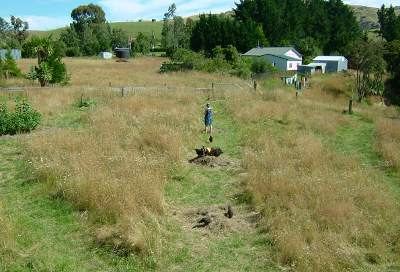Chooks for weeding and soil enhancement
I have read of the advantages of having your chooks in amongst your vegetables. The main benefits being their contribution to soil fertility by way of manure and their constant scratching which mixes and weeds the soil.
Unfortunately these animals are oblivious to the purpose of the garden and inevitably do damage, cause outrage and generally do as much harm as good. That is unless you develop some kind of movable enclosure or zoning system to restrict their activity to a designated spot. With this there is always the likelihood of escape and to me it doesn't really qualify as 'free range'.
So, I'm going to keep the chooks as far from the main garden as I can, and take certain crops to them once they have prepared the ground in advance.
The following outlines my process which can be done on a small or large scale based on your level of energy, number of chickens, available land etc.
Step 1 - Grass & Mowing
Because we have no stock in the paddock where the chooks live, the grass has grown very tall. I mowed clear strips so we could get around better and to mark where I wanted to do my planting. All the cut grass is then piled into rings at the locations where you think you want to do your future plantings. In my case I am planning to eventually have lines of fruit / shelter trees so have spaced my piles at 5 meter intervals.

This photo shows some of the mown strips in the chook paddock with dug patches at 5 meter intervals.
Step 2 - Dig
To encourage the cut grass to decompose dig the soil from the centre of the ring and pile it on top of the grass around the hole. Chooks love to scratch in soil to find grubs and also to dust bath.
If you want to expose more dirt then dig soil from round the outside of the ring and pile it on top of the grass also. As the chooks scratch in the dirt they will mix it in with the grass along with copious quantities of manure.
Step 3 - Feeding
To speed up the process and encourage the hens to visit the dirt mounds we scatter feed (barley) and scraps at the different piles. This also helps build up with worm population which in turn accelerates the soil improvement and nourishes the chooks.
Step 4 - More Digging
As the grass decomposes (helps if there has been some sun and rain) dig and move the soil from the outside of the ring into the centre hole. This mixes the grass and soil more and exposes some of the worms for the hungry hens. You should do this often but not to often so that the composting and worm growth has a chance to happen.
This may sound like a lot of work and I guess it is but I actualkly rather enjoy being out there on a nice day (after sitting in front of the computer) digging and interacting with the chooks.
Step 5 - Planting

 Eventually the mix will be a nice loose soil with plenty of organic matter composted in. Select something to plant on your spot. Your planting will be determined by the size of the area. So far I have planted several fruit trees (no protection required), pumpkin, zuccini and beans.
Eventually the mix will be a nice loose soil with plenty of organic matter composted in. Select something to plant on your spot. Your planting will be determined by the size of the area. So far I have planted several fruit trees (no protection required), pumpkin, zuccini and beans.
First photo shows beans around the outside with 3 zuccini in the middle. The second a larger area of mature zuccini plants. All were planted as seeds in place. (click to zoom)
In order to protect the seedlings I erect a circle or tube of netting. This can be free standing or with some kind of stakes for support depending on the diameter. This protection stays in place until the plants are large enough to survive the energetic activity of the scratching hens. In the case of the beans I have left the netting in place to provide a climbing wall.

